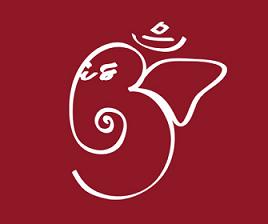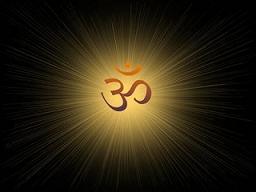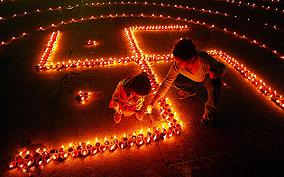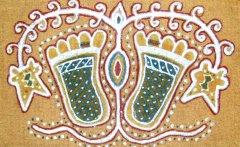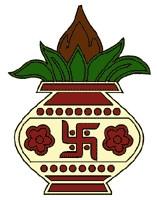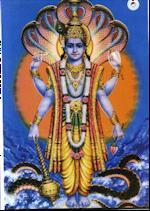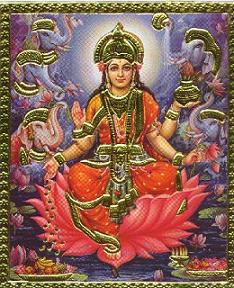For over 2500 years, many sacred symbols have held profound meaning for Indians. Even today, these shapes and graphic designs are used in the performance of daily rituals and worship…
Indians have a rare ability…they can live simultaneously in several centuries and eras with total comfort. In their thought, ideas, philosophy, attitude and religious rituals, there is an unbroken continuity of over 5000 years.
The history of India is punctuated with wars and conquests. Each new invasion has left a mark of its own on this country. But none has succeeded in stamping out India’s culture or way of life which has remained intact for thousands of years. Most recently, British rule and the industrial revolution also brought major changes to India. But even then, basic concepts tested and polished in the embers of time, have remained unchanged even as India stands on the threshold of the second decade of the 21st century.
An integral part of India’s culture is the wide variety of graphic designs and symbols which are used prolifically in everyday life. During the Vedic era (2500 BC) when the four great books of knowledge called the Vedas were composed, a number of these intricate figures sprang from the imagination of the philosophers as visual representations of the universe and the divine energy which rules it. Some figures were used as a focus of meditation. Others were used in rituals and sacraments. Some lent an artistic flavor to festivals and everyday life. Among all the graphic designs and symbols thus inherited by India, seven are deeply etched in the Indian psyche and are used in almost every Hindu home at one time or another.
•The foremost among these is the sacred Om. It is believed to be the visual depiction of the cosmic sound from which the universe originated. It is the syllable from which all matter and space originate. In its monosyllabic sound, it contains the Brahman or the entire universe and its energy. So fundamental is Om to Indian culture that it is the first shape that every child draws as he/she begins his/her education. It is also the first chant of the priest as he invokes the gods in any prayer. This motif can be seen on doorways, temples, account books, religious texts, cradles of newborn babies and on ceremonial clothes in a variety of colours and many embellishments. Om is also depicted as the true form of Ganesha, the deity of auspiciousness and good fortune as well as wisdom, knowledge and learning.
•The early Aryans looked upon the sun as the source of energy and life. As their belief in the dazzling power of the sun crystallized, they created an Apollo-like, golden-limbed deity – the sun god, who rides a golden chariot drawn by seven horses, representing the seven days of the week. They raised many exquisitely sculpted temples to venerate Surya, the sun god. A special graphic symbol was visualized to denote the sun’s energy and munificence. This symbol is the Swastika, a Sanskrit word which means ‘well-being’. The Swastika became a familiar motif to Westerners when the Nazis adopted it to symbolize their Aryan origins. Indians draw the Swastika in vermillion on business documents and festive and bridal clothes for good luck and fortune. They paint it on walls and thresholds of houses to energise the environment and they draw it on full pots during weddings and sacraments of worship. Linked with the glitter of gold, the Swastika is worn as a locket on a chain as a talisman to ward off darkness, despair and danger. Indeed, the word Swasti means well being and Swastika means that which creates well-being.
•Step across the doorway of any hut or home in the mud-walled, thatched villages in India and you will see tiny, delicately drawn female footprints on walls or thresholds. These stylized footprints drawn in vermillion are an ancient graphic design and belong to Lakshmi the goddess of lustre and good fortune. Particularly on festive days, women draw these auspicious footprints on thresholds at twilight time to welcome Lakshmi
, who bestows wealth and wisdom, health and good fortune upon her devotees.
•Throughout history, man has passionately yearned to conquer degeneration and death and to attain immortality. A graphic symbol which is ever present in all Indian rituals and worship represents this desire for everlasting life. The Poorna Kumbha or the full pot (of nectar) signifies a rich, full and well-lived life which brings human beings closest to immortality. In the Hindu cultural ethos, the rotund, full pot topped with a sprig of mango leaves and a coconut contains the mythical nectar of life and the waters of India’s sacred rivers. It is associated with fluidity and life-sustaining energy. The kumbha or the pot has inspired Indian sculpture, painting, textile motifs as well as folk art in all parts of India. It is a common motif in all temples and sacraments. Potters of every region use the motif to make exquisitely molded metal-ware and earthen-ware pots as decorative objects for homes. Poets, writers and thinkers see the full pot as a symbol of the mystic togetherness and completeness of all life.
•Commonly seen in most Asian and far eastern countries as well as Australia, the lotus is widely admired for its fragrant pink, blue or white flowers. In India, it is known by myriad names such as Padma, Nalin, Aravind, Utpala and many more. Throughout India’s cultural history, the lotus has been a powerful, sacred image and a spiritual symbol. In all Indic religions, namely Hinduism, Buddhism, Sikhism and Jainism, the lotus is considered a sacred flower. With its birth in unclean moss-infested water bodies, the lotus is a symbol of "spontaneous" generation of beauty. It represents divine birth, spiritual development and creation itself. As is seen from images, the lotus rises out of Vishnu’s navel and holds Brahma, the creator. This is why Vishnu is called Padmanabh. Divine knowledge is often compared to lotus opening itself petal by petal. Indeed, Jawaharlal Nehru once said that a person’s destiny depends upon how many petals of the inner lotus (atmakamal) he/she tries to open during his/her lifetime! The lotus is thus the inner sanctum of the human spirit and symbolizes peace, beauty, prosperity and a silence in which divinity and humanity come together. Goddess Lakshmi, the deity of beauty and opulence, stands in a lotus and is called Kamala. Goddess Saraswati, the deity of wisdom and knowledge holds white lotuses. Vishnu, the central deity of the Hindu pantheon, is seen carrying a Padma or lotus in his hand. A lotus bud symbolizes the spiritual potential of a human being. So loved is the divine beauty of the lotus that the eyes of goddesses, the holy feet of all deities and seers, the holy hands of all gods and goddesses are likened to lotuses. The lotus rises from muddy water to blossom as a pure, uncontaminated flower, Therefore it is a symbol of purity and resurrection. Additionally, it is the national flower of India.
•One of ancient cults of India is snake worship. Among the pantheon of Hindu gods, many are associated with snakes. Krishna, the most powerful incarnation of Vishnu, conquers Kaliya, the snake king who rules the depths of River Yamuna. Shiva is seen with a snake wound around his hair or neck. Vishnu lies on the Shesha or Anant, the cosmic serpent that holds the earth together. A coiled snake represents Kundalini, the dormant energy in human beings. In tradition, snakes are the protectors of all directions or Digpalas. Snakes are also protectors of the earth’s treasures and symbols of fertility.
•The Shankha or conch shell, is considered sacred for many reasons.
It is a part of the rituals of worship and is blown before the start of most ceremonies. Its sound symbolizes the cosmic music of the universe. In all rituals, the blowing of the Shankha announces the victory of the divine energy. Various deities are believed to be present in different parts of a Shankha. Among them are the moon, Varuna and the rivers Ganga and Saraswati. The Shankha is one of the four sacred objects that Vishnu holds in his hands. It is believed that the sound of the Shankha keeps away evil spirits and saves human beings from calamities. The Shankha is counted among the fourteen ‘jewels’ that emerged in the Samudra Manthan or churning of the cosmic ocean and mysteriously evokes the sound of the cosmic ocean.
These seven motifs and designs help to clarify complex, abstract ideas and concepts to the simple Indian mind. They originate in the ancient treatises of Hindu philosophy, the Vedas and the epics which are the epitomes of Indian culture and consciousness. It is incredible that these and other symbols have remained changeless and sacrosanct for almost 5000 years. They are used in the daily life of an Indian family often without a deep understanding of their meaning or their long and unbroken tradition which has made these symbols an integral part of India’s design treasure.
The author was Editor of Femina for 25 years. Vimla Patil is among India's senior most Journalists-Media persons. She excels in writing lifestyle pieces, women's concerns, travelogues, celebrity interviews, art-culture pieces about India. Visit her site www.vimlapatil.com
Also read:
• Question and Answers Indian Civilization
• Sacred Trees of the Hindus
• Seven Sacred Rivers
• The Spiritual Heritage of India
